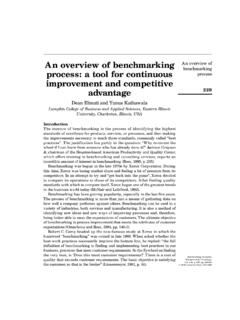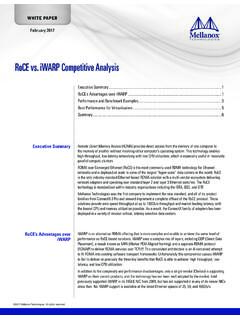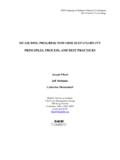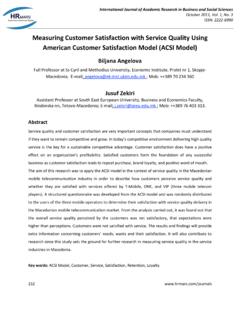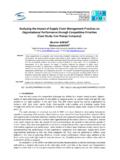Transcription of Happiness(and(productivity:Understanding(the ...
1 Happiness and productivity: Understanding the happy- productive worker Global Perspectives Series: Paper 4 DANIEL SGROI October 2015 SUMMARY POINTS o Happiness is now an accepted and important policy objective for governments alongside big aggregate targets such as economic growth or unemployment. However, there is surprisingly little work on the importance of happiness as an input to economic processes or measures such as productivity; usually it is considered only as an output or consequence of higher growth or income and not just an output. o This paper draws on experimental work linking happiness to productivity, by Andrew Oswald, Eugenio Proto and Daniel Sgroi undertaken at the University of Warwick involving over 700 participants.
2 O In three different styles of experiment, randomly selected individuals are made happier either through the use of a short (10 minute) comedy clip or through the provision of drinks and snacks. We check that these methods make the subjects happier (they do) and then go on to show that these individuals have approximately 12% greater productivity than a control group. o A fourth experiment studies major real- world shocks (bereavement and family illness) and the impact this has on current productivity. Lower happiness is systematically associated with lower productivity. This effect lasts for approximately 2 years.
3 These different forms of evidence, with complementary strengths and weaknesses, are consistent with the existence of a causal link between human well- being and human performance. o The productivity measure we employ allows us to differentiate between productivity that comes through effort and ability. We find that the main route from happiness to productivity is through increased effort by workers. o Private sector firms cannot ignore potential productivity gains in the current economic climate, and this might help public sector departments to offset the negative impact of spending cuts. Our findings help to illuminate what sort of policies might work and which sort of workers will benefit most.
4 Having scientific support for generating happiness- productivity cycles within the workforce should also help managers to justify work- practices aimed at boosting happiness on productivity grounds. HAPPINESS AND PRODUCTIVITY 1 ABOUT THE SERIES This is the fourth briefing paper in the Global Perspectives series - a new collaboration between the Social Market Foundation (SMF) and Warwick s Centre on Competitive Advantage in the Global Economy (CAGE). ABOUT THE AUTHOR Daniel Sgroi is an Associate Professor in the Department of Economics at Warwick University. He is a theme leader of Warwick s ESRC Centre on Competitive Advantage in the Global Economy (CAGE).
5 He obtained his DPhil at Nuffield College, University of Oxford, and worked at the University of Cambridge prior to joining Warwick. Most recently, he has published on a variety of applied economics topics including the economics of wellbeing, the optimal use of information and herding in financial markets in numerous journals including the Economic Journal, the Journal of Labor Economics, the European Economic Review, Games and Economic Behavior, Experimental Economics, the Journal of Economic Behavior and Organzation, and the Journal of Economic Theory. ABOUT CAGE Established in January 2010, CAGE is a research centre in the Department of Economics at the University of Warwick.
6 CAGE is carrying out a 10 year programme of innovative research. The centre s research programme is focused on how countries succeed in achieving key economic objectives such as improving living standards, raising productivity, and maintaining international competitiveness, which are central to the economic wellbeing of their citizens. Our research analyses the reasons for economic outcomes both in developed economies like the UK and emerging economies such as China and India. We aim to develop a better understanding of how to promote institutions and policies which are conducive to successful economic performance and endeavour to draw lessons for policy makers from economic history as well as the contemporary world.
7 Research at CAGE examines how and why different countries achieve economic success. CAGE defines success in terms of well- being as well as productivity. The research uses economic analysis to address real- world policy issues. The centre is distinctive in providing a perspective that draws on economic history as well as economic theory and is applied to countries at various different stages of economic development. ABOUT THE SOCIAL MARKET FOUNDATION The Social Market Foundation is a leading cross- party think tank, developing innovative ideas across a range of economic and social policy.
8 The SMF s current research themes are: Productivity and Growth; Cost of Living; and, Public Service Reform. We champion policy ideas which marry markets with social justice and take a pro- market rather than free- market approach. Our work is characterised by the belief that governments have an important role to play in correcting market failures and that a sustainable market economy rests on social and political foundations that are widely regarded as fair. SOCIAL MARKET FOUNDATION 2 Happiness and productivity: Understanding the happy- productive worker INTRODUCTION There is now no doubt that happiness as a policy objective is here to stay.
9 This should not be surprising. Happiness is after all something that everyone wants almost by definition. Consider how central the concept of happiness is to the United States Declaration of Independence and countless tracts by moral philosophers and political scientists from Plato, Aristotle, and Confucius onwards. To date the focus has been largely at the aggregate level. Objectives such as building subjective wellbeing measures to run in parallel with GDP, or adding happiness or life satisfaction measures to national surveys have all been about positioning happiness alongside the likes of GDP, unemployment, inflation or economic growth as key government objectives (most notably in 2011 when the UN released a World Happiness Report and the OECD launched a Better Life Index ).
10 However, just as we have worried in the past about the links between national income or economic growth and national level happiness measures, so too should we be interested in the links between individual- level income or productivity and happiness. The reason why is simple: at the individual level it may be possible to establish the direction of causation: while much of the debate so far has focussed on whether income or economic growth at the aggregate level generate happiness, we turn instead to look at the converse question: can happiness at the individual- level generate productivity improvements?


